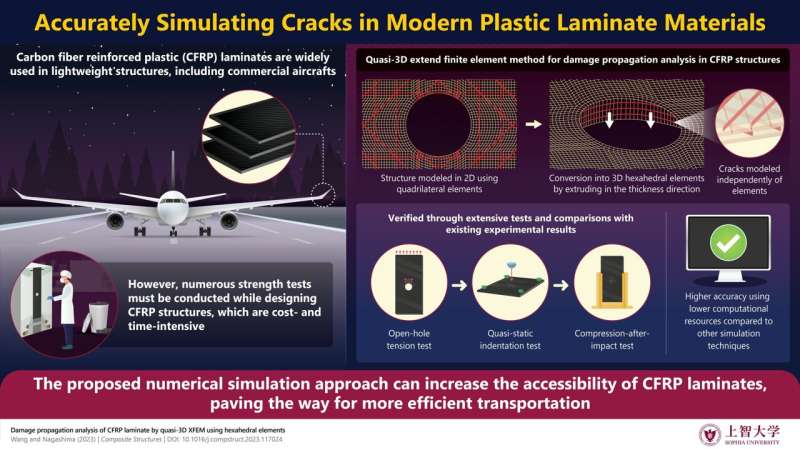This article has been reviewed according to Science X's editorial process and policies. Editors have highlighted the following attributes while ensuring the content's credibility:
fact-checked
proofread
Simulating damage propagation in composite materials to realize high-quality carbon fiber reinforced plastics

Structural materials with useful mechanical properties have applications in a diverse range of fields. A reliable way to enhance the properties of structural materials is to make them lighter without compromising their strength.
Carbon fiber reinforced plastics (CFRPs) are perhaps the most prominent example of this approach. These plastics are made up of tiny, yet extremely strong threads of carbon atoms held together by a plastic matrix. Owing to their low weight, high durability, and exceptional mechanical performance, CFRP laminates are being incorporated into state-of-the-art aerospace applications, transportation, and construction.
However, designing CFRP laminates can be a very time-consuming endeavor. Engineers must run multiple strength tests to benchmark CFRP specimens whenever they adjust a given design. This drives up the cost of the final product and hinders the applications of CFRPs in a wider range of fields.
Against this backdrop, a duo of researchers, Dr. Chenyu Wang, a former Ph.D. student at the Graduate School of Sophia University, and Professor Toshio Nagashima from Sophia University, developed a novel method to conduct numerical simulations of damage propagation in CFRP laminates. Their findings were published online in the journal Composite Structures.
The researchers based their approach on a quasi-3D version of the extend finite element method (XFEM). In FEM, a structure or material is divided into small sub-regions known as elements, followed by the solving of physical equations for each element, to determine the overall response of the system. The "extend" version, which has been used in this study, adds functions that capture local effects around discontinuities, enabling more accurate modeling of damage propagation in form of crack growth.
Notably, since CFRP laminates are made of stacked layers of material, modeling them as flat planes (2-dimensional or 2D) would fail to capture anomalies such as delamination.
In contrast, a 3-dimensional (3D) FEM simulation would be computationally intensive and complex to set up. To overcome these issues, the researchers took a balanced approach. They first modeled the desired CFRP laminate as a 2D structure composed of quadrilateral finite elements and marked the position where cracks might occur. Then, they projected this structure in the thickness direction, while the models used to simulate delamination and matrix crack were automatically generated through their simulation system.
This strategy made the computations manageable and the modeling to simulate CFRP damage more easily and efficiently.
To verify the validity of their approach, the researchers ran simulations of three different strength and damage propagation tests on CFRP laminates and compared their results with the experimental data reported in other studies.
The first was an open-hole tension test, in which a CFRP laminate with a circular hole in the middle was pulled from one end while the other end was anchored.
The second was a quasi-static indentation (QSI) test, where a hard semi-sphere was pressed slowly and steadily against a CFRP laminate.
Lastly, the third test was the compression-after-impact test, in which the damaged specimens from the QSI test were subjected to a compressive force to assess their integrity and damage tolerance.
Overall, the results of the proposed simulation method agreed well with the experimental data, outperforming the existing quasi-3D XFEM-based techniques. Confident about the potential of the novel approach, Dr. Wang says, "The applications of composite materials such as CFRP will become more extensive and efficient if the results of this study are utilized in related fields."
The widespread adoption of CFRPs is also likely to have important ecological implications. "In the future, if the damage of composite materials can be predicted more efficiently and accurately via numerical simulations, their cost will decrease. If these lightweight and high-strength materials are further applied in transportation, it will have a positive impact on energy savings and environmental protection," adds Dr. Wang.
If commercial aircraft could lower their fuel consumption and time taken for design by incorporating CFRPs, the cost of flying could significantly reduce.
More information: Chenyu Wang et al, Damage propagation analysis of CFRP laminate by quasi-3D XFEM using hexahedral elements, Composite Structures (2023). DOI: 10.1016/j.compstruct.2023.117024
Provided by Sophia University





















